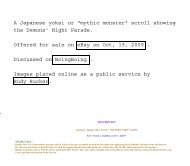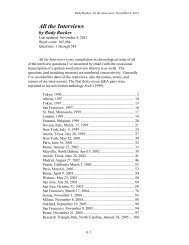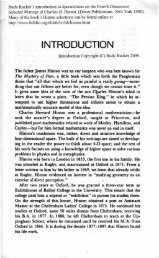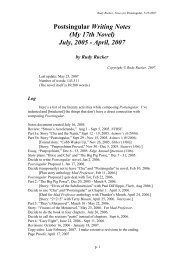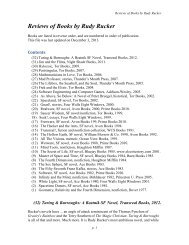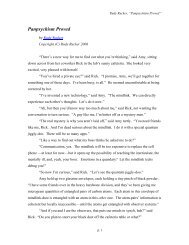Notes for the Lifebox, the Seashell, and the Soul - Rudy Rucker
Notes for the Lifebox, the Seashell, and the Soul - Rudy Rucker
Notes for the Lifebox, the Seashell, and the Soul - Rudy Rucker
Create successful ePaper yourself
Turn your PDF publications into a flip-book with our unique Google optimized e-Paper software.
<strong>Notes</strong> <strong>for</strong> The <strong>Lifebox</strong>, <strong>the</strong> <strong>Seashell</strong>, <strong>and</strong> <strong>the</strong> <strong>Soul</strong>, by <strong>Rudy</strong> <strong>Rucker</strong><br />
dimension <strong>and</strong>, secondly, <strong>the</strong> maximum dimensionality of a fractal is bounded by <strong>the</strong> space<br />
that it sits in. The Koch curve is an unruly line in two-dimensional plane, <strong>and</strong> it’s thought of<br />
as having dimension 1.26. A mountain is a messy surface in three-dimensional space, <strong>and</strong> its<br />
dimensionality might be something like 2.1. If we had a sufficiently spiky fractal we might<br />
actually need a higher N-dimensional space to hold it without its part having to overlap.<br />
Speaking of mountains, <strong>the</strong> parts of a ma<strong>the</strong>matical fractal need not be perfect copies<br />
of <strong>the</strong> whole. It’s perfectly all right to have <strong>the</strong> patterns vary a bit from level to level. The<br />
idea is that a spur on a mountain looks quite a bit like <strong>the</strong> whole mountain, even though it<br />
isn’t an exact replica. The outcroppings on <strong>the</strong> spur in turn resemble <strong>the</strong> spur, even though<br />
<strong>the</strong>y aren’t scale models of it. The outcroppings have mountainous little bumps on <strong>the</strong>m, <strong>and</strong><br />
<strong>the</strong> bumps have little jags, <strong>and</strong> if you get a magnifying glass you’ll find zigs <strong>and</strong> zags upon<br />
<strong>the</strong> jags.<br />
Among <strong>the</strong> physical <strong>for</strong>ms that are commonly thought of as being like fractals are <strong>the</strong><br />
following. Dimensions between 1 <strong>and</strong> 2: coastlines, trees, river drainage basins. Dimensions<br />
between 2 <strong>and</strong> 3: mountains, clouds, sponges. Fractal <strong>for</strong>ms are found within <strong>the</strong> human body<br />
as well. Among <strong>the</strong>se are <strong>the</strong> circulatory system, <strong>the</strong> nervous system, <strong>the</strong> texture of <strong>the</strong> skin,<br />
<strong>the</strong> eye’s iris, <strong>the</strong> convoluted surface of <strong>the</strong> brain, <strong>and</strong> <strong>the</strong> spongy masses of <strong>the</strong> internal<br />
organs.<br />
A tree is a particular kind of fractal that’s particularly important <strong>for</strong> <strong>the</strong> present<br />
discussion. If you look closely at a tree, you’ll readily notice that it has a trunk with big<br />
branches. There are subbranches coming off of <strong>the</strong> branches, <strong>and</strong> <strong>the</strong>re are subsubbranches<br />
upon <strong>the</strong> subbranches, <strong>and</strong> so on through five to seven levels of branching.<br />
I used to have <strong>the</strong> mistaken idea that a tree branched by splitting <strong>the</strong> tips of its<br />
branches, but this isn’t really <strong>the</strong> way it works. The way a tree grows is that a new branch<br />
<strong>for</strong>ms upon <strong>the</strong> smooth part of any sufficiently long piece. The basic move is like a<br />
branchign tree.<br />
[Show A branching tree fractal of dimension 1.46.]<br />
You might object to my calling <strong>the</strong> oak tree in your yard a fractal, because your oak’s<br />
branching structure does not in fact have endlessly many levels of detail (as a true<br />
ma<strong>the</strong>matical fractal would). When you get down to <strong>the</strong> twig level, <strong>the</strong> parts no longer<br />
resemble <strong>the</strong> whole. No matter. Even though an actual physical tree has a limited number of<br />
branching levels, it can be useful to think of it being a fractal. What we’re doing here is a<br />
special kind of idealization in which we approximates high complexity by infinite<br />
complexity. Oddly enough, this makes things easier. As <strong>the</strong> ma<strong>the</strong>matician Stan Ulam once<br />
said about a particular problem, “The infinite case is easy. The finite case takes too long.”<br />
Alright, now I’m ready to state my point. Both <strong>the</strong> Web <strong>and</strong> <strong>the</strong> mental world of your<br />
ideas are N-dimensional fractal trees.<br />
There is a loose sense in which thinking is like moving about in a space of ideas. I<br />
visit this notion or emotion, <strong>the</strong>n that one, <strong>and</strong> <strong>the</strong>n perhaps I return to <strong>the</strong> first thought. My<br />
familiar thoughts are somewhat fixed <strong>and</strong> persistent, a bit like objects in a l<strong>and</strong>scape.<br />
Suppose that I use <strong>the</strong> word “mindscape” to st<strong>and</strong> <strong>for</strong> <strong>the</strong> manifold of possible thoughts.<br />
There’s clearly some overlap between my mindscape <strong>and</strong> yours. It’s suggestive to<br />
p. 35




